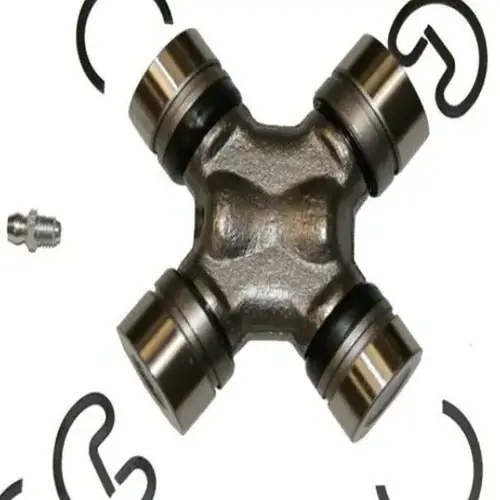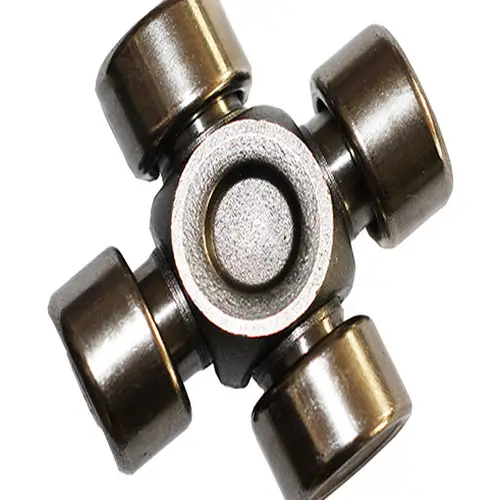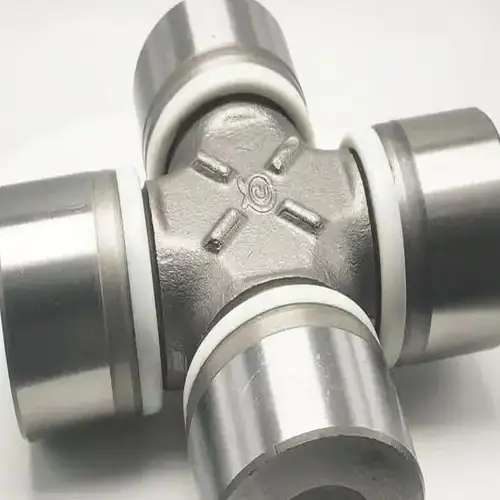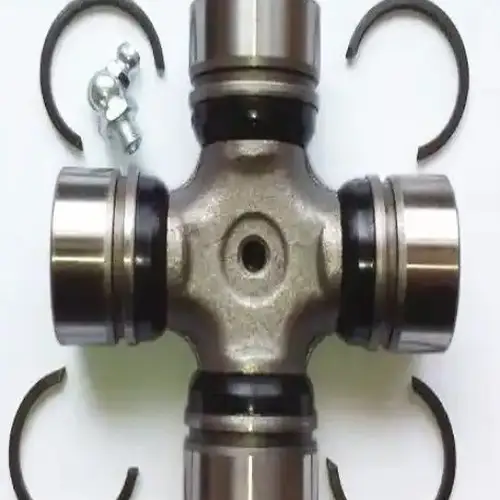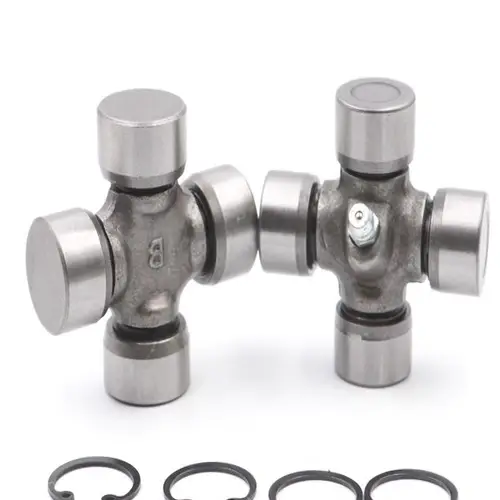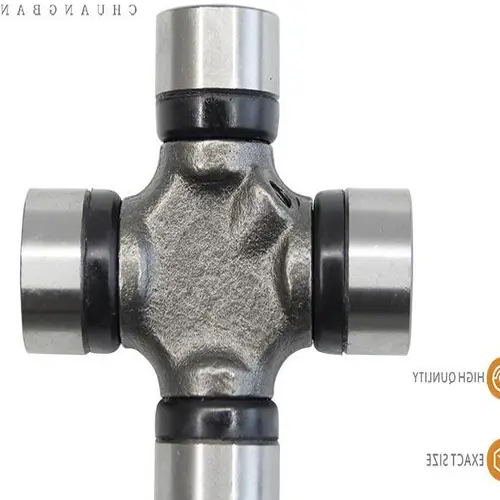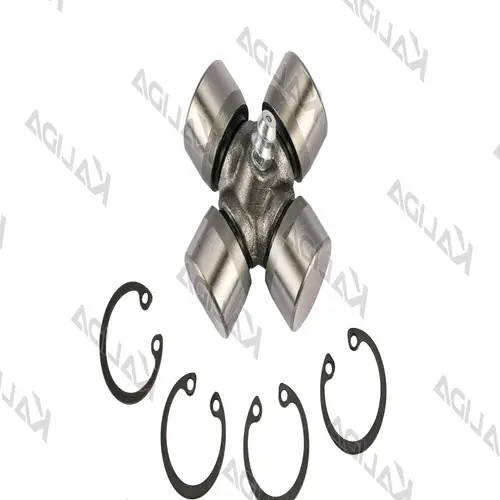
China Custom Gut-20 Universal Joint OEM for Air Compressors
Product Description
The Universal Joint, also known as U-joint, Cross joint, or Cardan joint, is an essential component in many mechanical assemblies. Its unique design allows rigid rods to bend in multiple directions, making it indispensable in the transmission systems of various vehicles such as cars, buses, trucks, and tractors. These joints are critical for ensuring smooth rotary motion transfer across multiple angles.
| Part Name | Universal Joint |
| Part Number | GUT-20, 5711-36571, 5711-36034, 5711-36050, 5711-60030 |
| Weight | 0.76KG |
| Car Name | DYNA, STOUT2000, LAND CRUISER, COASTER… |
| Size | 32x61x93mm |
| Packing Details | Snap Rings: 4pcs, Grease Nipples: 1pcs |
| Warranty | 12 Months |
| Place of Origin | RuiAn WenZhou ZheJiang |
Product Details
Product: Universal Joint.
Hardness: HRC58-64.
Brand: LR or OEM service.
Packing: Plastic bag, color/white box, carton, wood pallet.
Sample policy: Free sample, freight collect.
Other Instructions
1. It is FOB HangZhou price. (Also can send free to HangZhou / Ningbo ZheJiang warehouse.)
2. The material is 20Cr, ensuring no complaints from your customers. (Also available in 20Mn, 20CrMnTi)
3. Delivery time is 40 days with a 20Gp container, ensuring timely delivery.
4. Custom development according to customer drawings or samples.
5. OEM service available.
6. Full range for the universal joint.
7. High quality and reasonable price.
Packaging & Shipping
Standard neutral packing with carton.
Delivery detail: 30-45 working days, depending on actual production conditions.
Our Other Products
EVER-POWER GROUP is renowned for supplying a wide range of industrial products, including:
- Agricultural gearboxes
- Power output shafts
- Sprockets
- Fluid couplings
- Worm gear reducers
- Gears and racks
- Roller chains
- Pulleys and timing pulleys
- Planetary gearboxes
- Timing pulleys
- Bushings
We emphasize high-quality products, competitive prices, and attentive services. Customers are welcome to customize drawings and samples.
FAQs
Q1: What materials are used for the Universal Joint?
A1: We use high-quality materials such as 20Cr, 20Mn, and 20CrMnTi to ensure durable and reliable performance.
Q2: Can you provide custom designs based on customer specifications?
A2: Yes, we can develop products according to customer drawings or samples, offering OEM services.
Q3: What is your delivery time?
A3: Our typical delivery time ranges from 30 to 45 working days, depending on the actual production conditions.
Q4: What is your sample policy?
A4: We offer free samples, but the freight cost is collected.
Q5: What packaging options are available?
A5: Our products are packed in plastic bags, color/white boxes, cartons, and wood pallets to ensure safe and secure delivery.
All the content of the page is from the Internet, the content is only as a reference for product selection, our products are replacement parts and not original spare parts; we are not the holder of the original trademarks of the content, our products are only suitable for after-sales replacement parts and not original spare parts, our replacement parts can be perfectly adapted to the original spare parts; if you need to buy original spare parts, please contact the original factory to buy. If you want to buy original spare parts, please contact the original supplier for purchase.
Performance Characteristics of Universal Joints
Universal joints, also known as U-joints, are mechanical devices that allow the transmission of rotary motion between two shafts that are not in a straight line. Key performance characteristics include:
- Flexibility: Universal joints can accommodate a wide range of movement angles, making them versatile for various applications.
- Durability: Constructed from high-quality materials, U-joints are designed to withstand significant stress and wear over long periods.
- Efficiency: They provide efficient power transfer with minimal loss, ensuring optimal performance of the connected machinery.
- Maintenance: Modern U-joints require minimal maintenance, reducing downtime and operational costs.
- Compact Design: Their compact structure allows for easy integration into complex systems without consuming excessive space.
Types and Characteristics of Universal Joints
Universal joints come in various types, each designed for specific applications:
- Single Universal Joints: These are the most basic type, allowing for angular misalignment between two shafts.
- Double Universal Joints: Used when a greater degree of misalignment is required, double U-joints consist of two single joints connected by a shaft.
- Constant Velocity Joints: These joints provide uniform motion transfer, making them ideal for automotive applications.
The choice of material also impacts the performance of U-joints:
- Steel: Offers excellent strength and durability, suitable for heavy-duty applications.
- Aluminum: Lightweight and resistant to corrosion, ideal for aerospace and marine applications.
- Composite Materials: Provide a balance of strength, weight, and corrosion resistance, suitable for a variety of industrial uses.
Application of Universal Joints in Various Industries
Universal joints are indispensable in numerous sectors:
Automotive Industry:
Used in the drivetrain to transmit power from the engine to the wheels, ensuring smooth and efficient vehicle operation.
Industrial Machinery:
Facilitate the transfer of motion between misaligned shafts in heavy machinery, enhancing operational efficiency.
Aerospace:
Ensure precise motion control in aircraft systems, contributing to the overall safety and efficiency of flight operations.
Marine Equipment:
Used in propulsion systems to ensure reliable power transmission in challenging marine environments.
Railways:
Critical in the operation of train bogies and other moving parts, ensuring smooth and reliable train movement.
Future Development Trends and Opportunities for Universal Joint Products
The future of universal joints is shaped by advancements in materials science, manufacturing techniques, and engineering design. Key trends and opportunities include:
- Advanced Materials: Development of new materials with improved strength, durability, and corrosion resistance.
- Precision Engineering: Improved manufacturing techniques to produce joints with higher precision and performance.
- Integration with Smart Technologies: Incorporation of sensors and IoT capabilities to monitor performance and predict maintenance needs.
- Environmental Considerations: Development of eco-friendly materials and lubricants to reduce environmental impact.
These trends indicate a promising future for the universal joint market, with continuous improvement and innovation driving growth and new opportunities.
How to Choose a Suitable Universal Joint
Selecting the right universal joint involves several considerations:
Determine Application Requirements:
Understand the specific needs of your application, including the type of motion and misalignment angles involved.
Evaluating Power Requirements:
Assess the torque and power needs of your system to ensure the U-joint can handle the load.
Check Speed and Torque Specifications:
Ensure the universal joint can operate at the required speeds and torque levels without failure.
Measuring the Length of the Shaft:
Accurately measure the distance between the connected shafts to select a joint of appropriate length.
Evaluate Connection Type:
Choose a joint with the correct connection type (e.g., keyed, splined) to match your system’s requirements.
Check Safety Features:
Ensure the U-joint includes necessary safety features, such as protective covers or fail-safes, to prevent accidents.
Conclusion
Universal joints are essential components in various industries, offering flexibility, durability, and efficiency in power transmission. By understanding their performance characteristics, types, applications, and future trends, you can make informed decisions when selecting the right U-joint for your needs. With ongoing advancements and innovations, the future of universal joints looks promising, ensuring their continued relevance and importance in diverse applications.
Author: Dream
